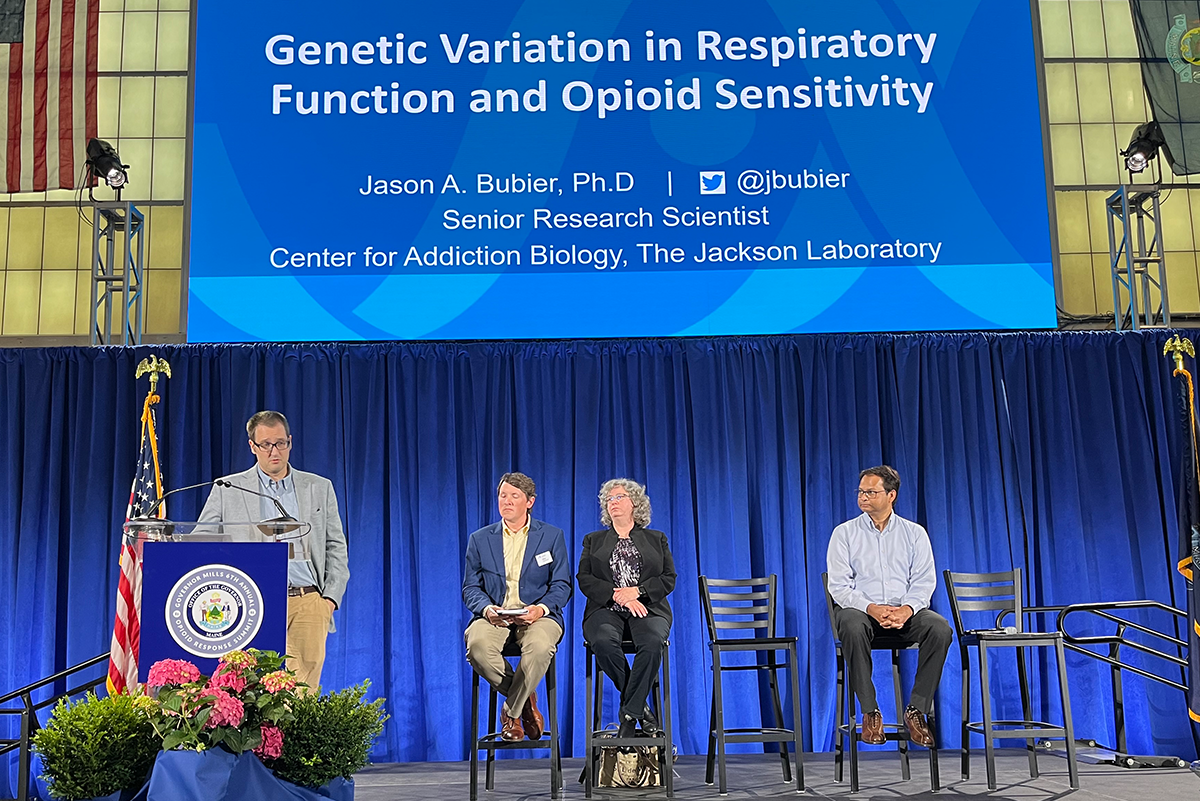
JAX researchers, Jason Bubier, Ph.D. and Vivek Kumar, Ph.D., who study the genetics of complex traits like addiction, participated in a panel at Governor Mills’ 6th annual Opioid Response Summit on July 25. The panel focused on the physiological basis of addiction and overdose, the importance of employing available interventions, and how educating the public on the science of substance use disorders can help in reducing the stigma that surrounds them.
The Summit, held at Central Maine Community College in Auburn, is an annual event focused on the state’s commitment to fight the opioid epidemic, convening leaders from around Maine and beyond to discuss strategies, ideas and research. Speakers included Gov. Mills, Gordon Smith, director of Opioid Response, and keynote speaker Miriam E. Delphin-Rittmon, assistant secretary for Mental Health and Substance Use in the U.S. Department of Health and Human Services. Participants in a program called “Voices of Recovery” shared powerful personal stories throughout the day, garnering standing ovations from an often-emotional crowd.
“My administration is doing all we can to stop drugs from reaching Maine, to prevent substance use disorder at an early age, to treat it when we can’t prevent it, and to set people on a lifelong path to recovery – above all, to save lives,” said Gov. Mills in her remarks. Under her leadership Maine has taken important measures to address the epidemic, including establishing new recovery centers across the state, addressing insurance coverage for substance use disorders through an expansion of the MaineCare program, and increasing distribution of the overdose reversal agent naloxone by over 100 percent from 2020 to 2022.
In their panel, “Current Research in Precision Medicine and Addiction,” Bubier and Kumar presented highlights of their addiction-focused research, along with panelist Tamara King, a professor at the University of New England who studies the biology of pain. The panelists, moderated by Michael McKernan, JAX’s director of government and community relations, spoke to a crowded auditorium, sharing slides about the genetics of addiction, and answered a robust set of question from the audience following their talks.
Bubier, who studies susceptibility to overdose in his research, noted there can be staggering differences in response to doses of opioid among genetically diverse mice, suggesting that a person cannot know what their individual response to a drug like fentanyl might be, or their individual propensity for overdose. Kumar discussed his work studying the genetics of addiction, and the complicated biological markers that make up a predisposition to substance use disorders. He shared slides about the innovative AI methods being developed and utilized at JAX to allow for advanced research into mouse behavior, yielding exciting new results in the addiction research field.
“I see outreach as part of my mission,” said Kumar, following the event. “We need to explain the biology of addiction to reduce stigma – and offer hope.”
Both researchers regularly participate in events like the Summit in order to share their findings with communities in Maine affected by addiction, creating a direct connection between scientific research and the people it impacts most.
“There is something about being in a crowd of like-minded people, especially when discussing something that is so stigmatized, working together in whatever way we can to help people,” said Bubier, who has attended all six of the Summits, and presented at two. “I find attending each year helps me to refocus my efforts on the ‘why’ of my research. And I feel like the science of addiction has a message for people in recovery or suffering from substance use disorders: it’s not your fault, you are not a bad person, and there is biology, life history and generational trauma that help explain substance use disorders. Addiction is a disease. There are many pathways to get there, and coming to this Summit gives me hope that there are many pathways out, as well.”